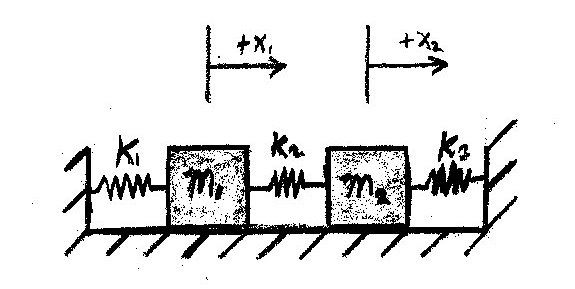Coupled Oscillator: Hellie: Difference between revisions
Jump to navigation
Jump to search
| Line 105: | Line 105: | ||
<math>e^{At}=\mathcal{L}^{-1}\left\{ |
<math>e^{At}=\mathcal{L}^{-1}\left\{[SI-A]^{-1}\right\}\,</math> |
||
<math>[SI-A]\,</math> |
|||
= |
|||
<math> |
|||
\begin{bmatrix} |
|||
S&1&0&0 \\ |
|||
\frac{(-50 N/m)}{15 kg}&S&\frac{-100 N/m}{15 kg}&0 \\ |
|||
0&0&S&1 \\ |
|||
\frac{100 N/m}{15 kg}&0&\frac{(250 N/m)}{15 kg}&S |
|||
\end{bmatrix} |
|||
</math> |
|||
Written by: Andrew Hellie |
Written by: Andrew Hellie |
||
Revision as of 21:05, 30 November 2009
Problem Statement
Write up on the Wiki a solution of a coupled oscillator problem like the coupled pendulum. Use State Space methods. Describe the eigenmodes of the system.
Initial Conditions:
State Equations
=
With the numbers...
=
Eigenmodes
- There are three eigenmodes for the system
- 1) m1 and m2 oscillating together
- 2) m1 and m2 oscillating at exactly a half period difference
Solve Using the Matrix Exponential
=
Written by: Andrew Hellie









![{\displaystyle e^{At}={\mathcal {L}}^{-1}\left\{[SI-A]^{-1}\right\}\,}](https://wikimedia.org/api/rest_v1/media/math/render/svg/7e4f88ccaa345b7b19ab22653c680a22602d0674)
![{\displaystyle [SI-A]\,}](https://wikimedia.org/api/rest_v1/media/math/render/svg/6c3c74fb36f1bde7543f23c3a5d8043ba853a98e)
